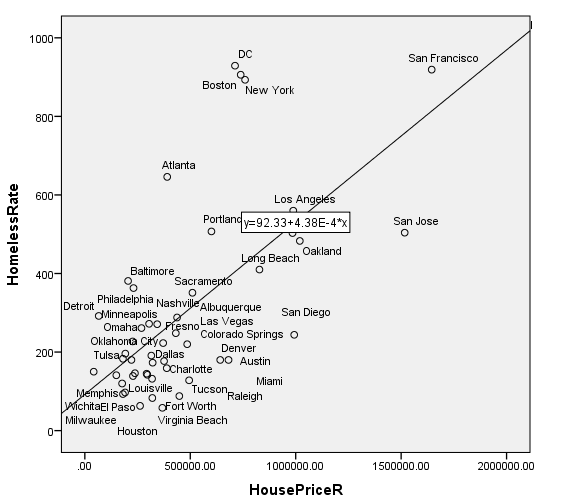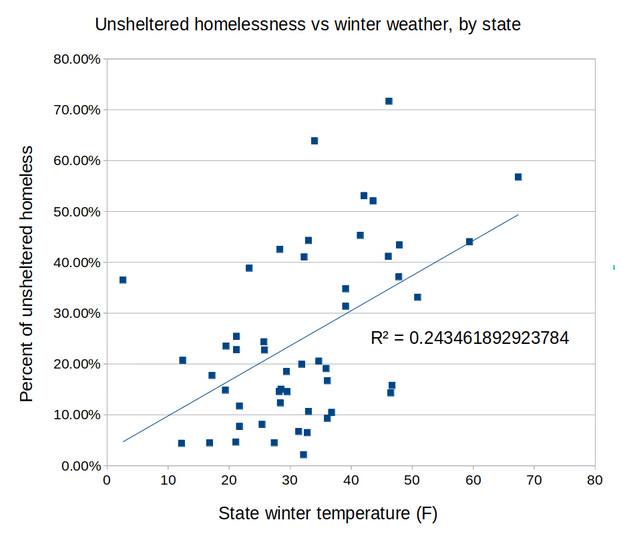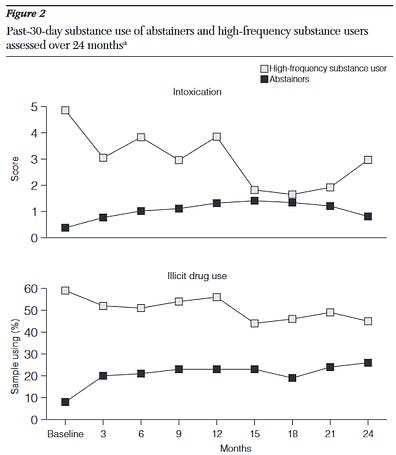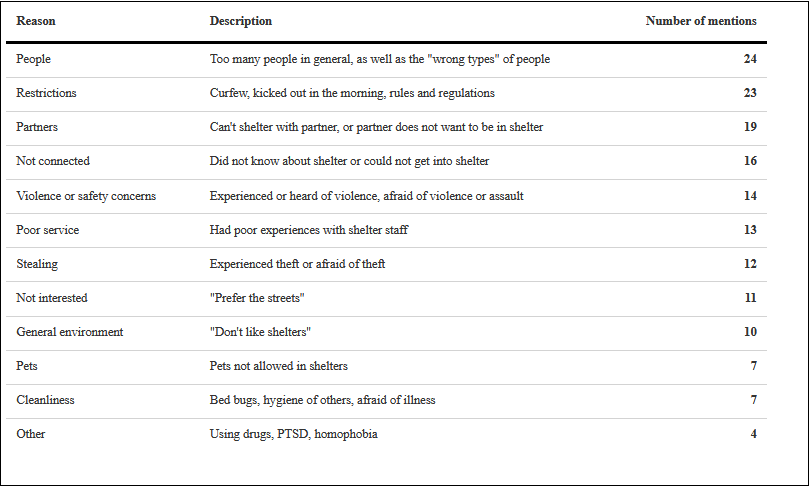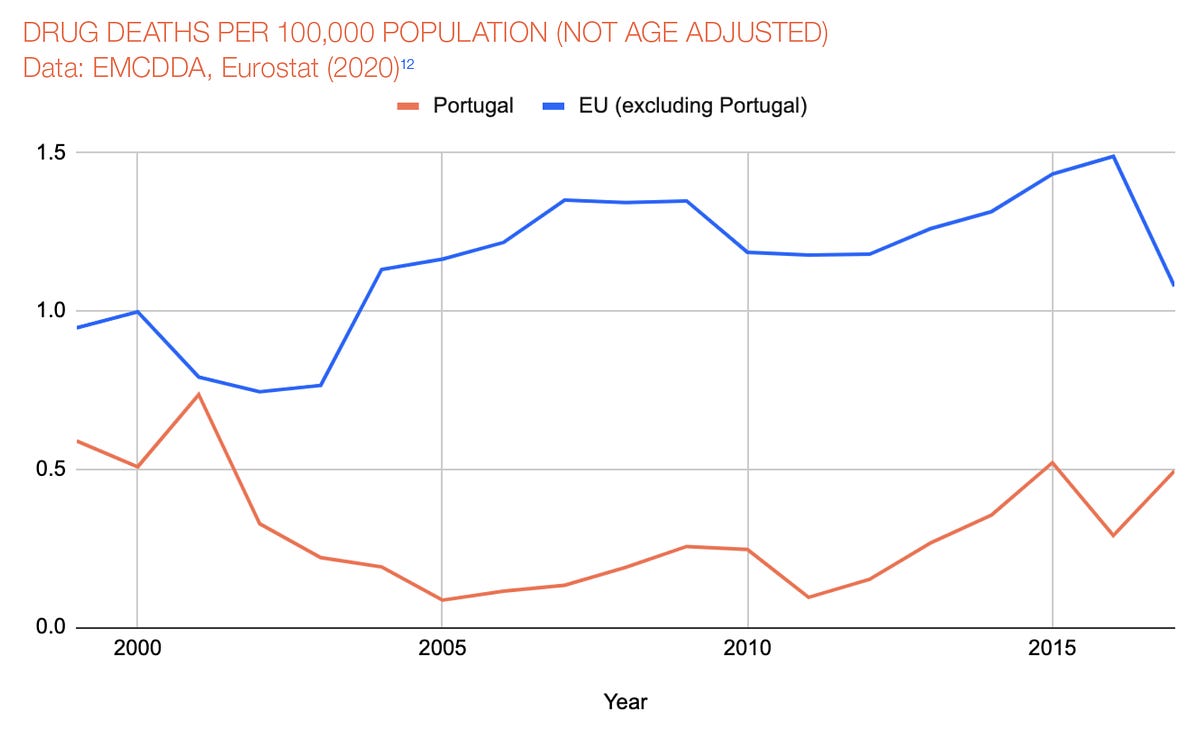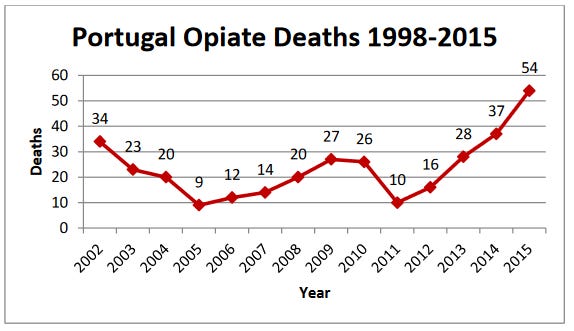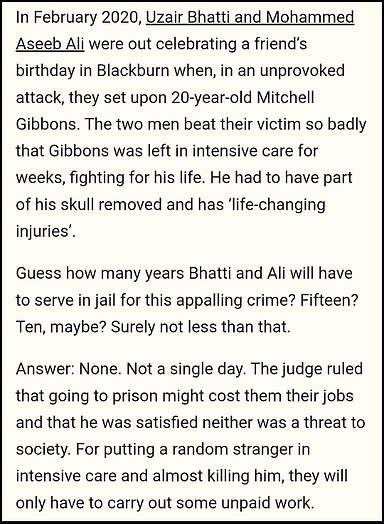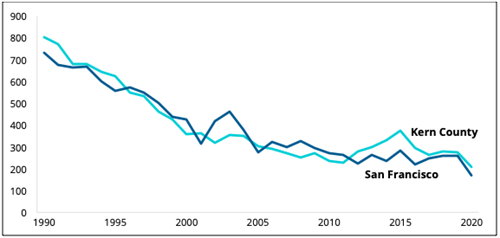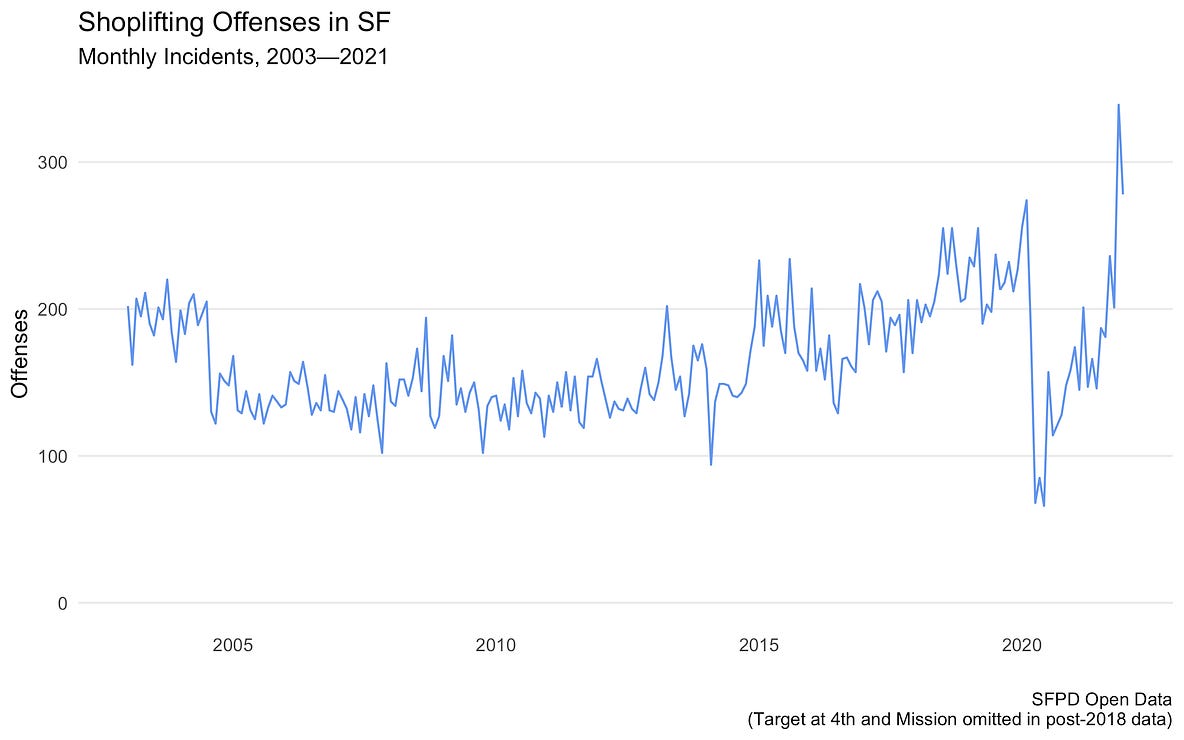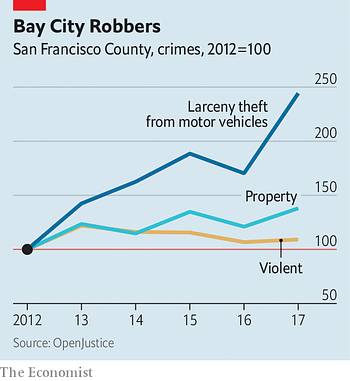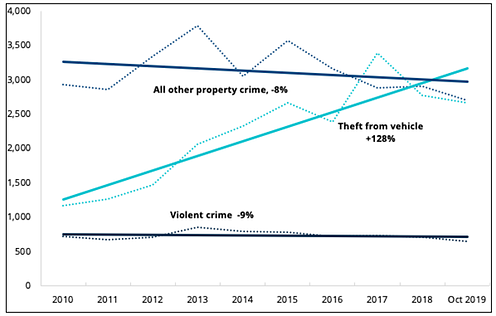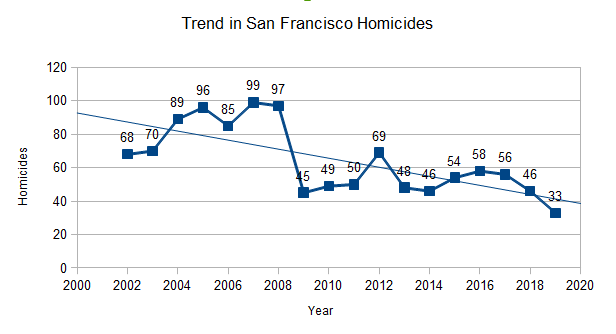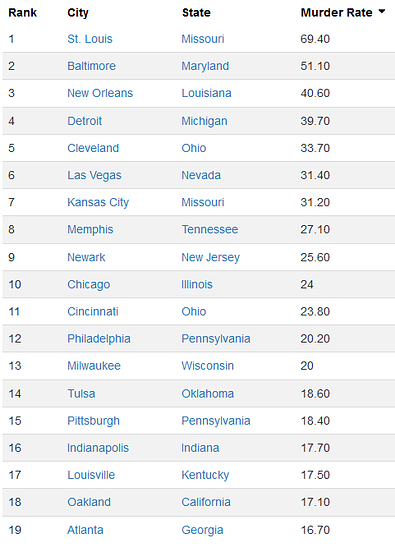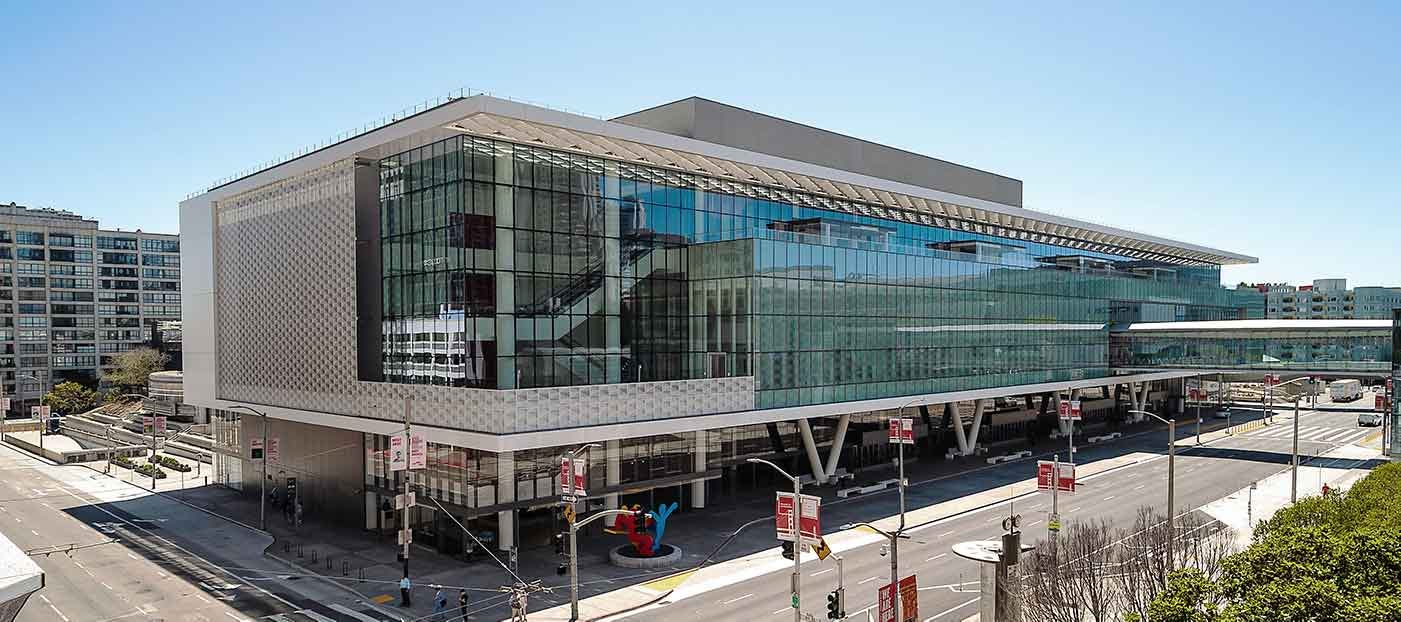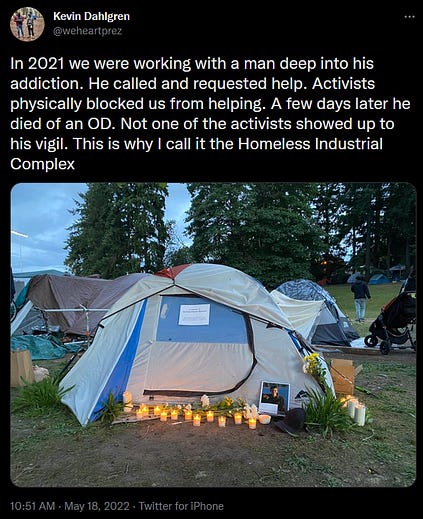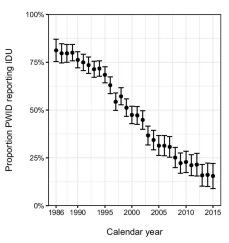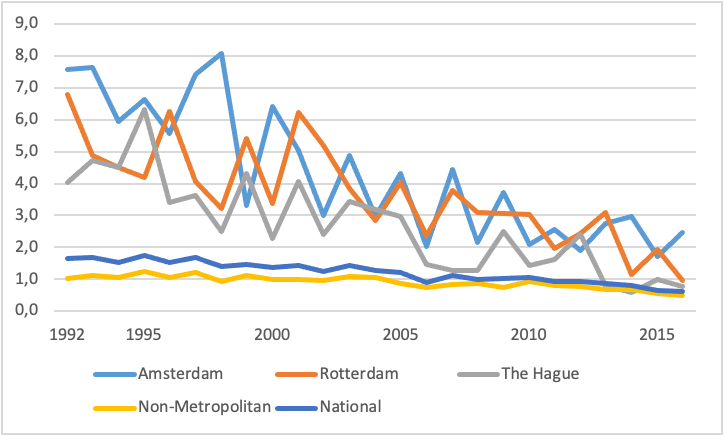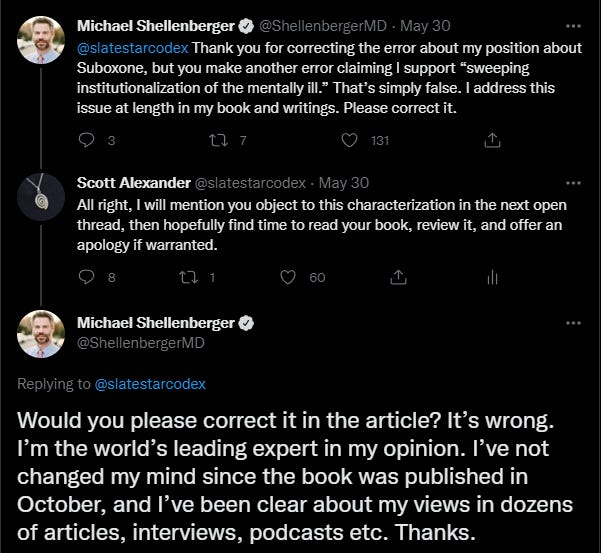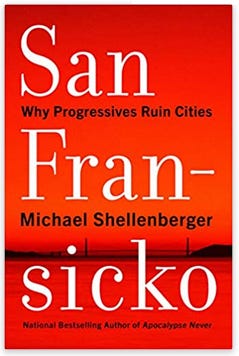Astral Codex Ten - Book Review: San Fransicko
Last month I discussed the platforms of twenty-six candidates for California governor. One candidate, author and activist Michael Shellenberger, objected to my characterization of him, so I read his book San Fransicko to learn more and decide whether I owed him an apology. San Fransicko is subtitled “Why Progressives Ruin Cities”. It builds off the kind of stories familiar to most Bay Area residents:
Things haven’t always been like this. San Francisco used to be one of the safest and most beautiful cities in the world. Shellenberger opens with the story of a 1970s SF candidate who campaigned on a message of public cleanliness, promising stronger punishments for owners who failed to pick up after their dogs. The message was a hit, so much so that the increased community and social pressure was enough to reverse the dog-poop-in-parks problem with minimal police enforcement. (that candidate’s name? Harvey Milk) But jump forward forty years, and:
This is a good introduction to San Fransicko. It adequately telegraphs what you’ll be getting in the rest of the book: scenes of devastating human misery and urban decay, little-known tidbits from California history, and very precise statistics. But that makes it hard to review. It makes enough different claims to leave the reader feeling kind of overwhelmed. If the claims are true, then the book is great and important. If they’re false, it’s bad and damaging. I felt that the fairest way to review this book was to meet it on its own terms with deep dives into ten of its key claims. Claim 1: Homelessness Isn’t Just About HousingNothing is ever just about one thing. But San Fransicko starts by quoting some experts who say homelessness is mostly a matter of poverty and housing costs, then expresses skepticism in that narrative, instead preferring to focus more on drugs and mental illness. Alyssa Vance investigates whether housing costs predict homelessness at the level of US states, and finds that they do, r^2 = 0.69. The outlier below is DC; removing it brings the correlation to 0.73. I was suspicious of using a state-based analysis to talk about cities, so I repeated her work with the 50 biggest US cities, using two different sets of price data - one from Kiplinger, one from Zillow. I found the Zillow numbers a little more plausible; here they are: This was slightly lower, r^2 = 0.42, but still pretty good! I also don’t think my city homelessness data were perfect (people report homelessness data not by city but by “continuum of care area”, and it’s complicated to figure out what the overall population of each area is), so it wouldn’t surprise me if that’s responsible for most of the decay from Alyssa’s analysis to mine. Here you can see that San Francisco has a pretty high homelessness rate, but no worse than some other big cities like DC, Boston, and New York (Shellenberger, to his credit, mentions this in the book). So how come everyone talks about SF all the time? Alyssa gives two main reasons. First, SF homeless tend to concentrate in a few areas downtown; this is also where a lot of the tourists and businesspeople are, so the average tourist or businessperson in San Francisco sees a lot more homeless people than they would if they were evenly distributed throughout the city. And second, SF homeless are less likely to be sheltered than homeless people elsewhere; Shellenberger notes that “over 99% of New York’s homeless have access to shelter. In San Francisco, just 42% do” (see here for other cities).
We’ll talk more in Part 4 about why this might be, but one common theory is climate: San Francisco has year-round above-freezing temperatures, so there’s less urgency to shelter everyone. Alyssa shows that the relationship between temperature and percent unsheltered is strong: So one possible conclusion is that SF has around the amount of homelessness you would predict from its very high housing prices, and around the percent unsheltered you would predict from its balmy winter weather, and there’s nothing further to be explained. Shellenberger does not like this conclusion.
This feels like kind of a shell game. San Francisco’s mild climate alone can’t explain why it has more homeless people per capita than Miami or Houston. But as the graph above shows, housing prices do explain about 75% of the difference between SF and those two cities. But because the book talks about the Miami-SF discrepancy in the paragraph about climate instead of the paragraph about prices, it makes it sound like a mystery that neither prices nor climate can explain. The Zillow article mentioned is Homelessness Rises Faster Where Rents Exceed A Third Of Incomes, which is based on this study. Shellenberger’s summary is not really the researchers’ conclusion. The researchers do not use the terms “local policy” or “social attitudes” in the paper itself. The popular summary does mention those terms in one sentence, but only to explain that the paper includes a term representing “latent factors” that they’re not going to bother distinguishing from each other in their model, and some of those terms could be local policy or social attitudes. Later they mention there are some outliers in their model (eg Houston), and it would be reasonable to assume that the latent factors help explain the outliers, but they don’t give us any reason to think that this is more interesting than the fact that every model ever will have outliers. But also, this is one study by Zillow. Alyssa and I both tried the same analysis, and found the same thing, with a correlation that’s unusually high for this kind of work. Sure, there are outliers, but San Francisco isn’t one of them. San Francisco is only a couple of percent off where the regression line would predict. That leaves the point about Palo Alto and Beverly Hills. They “have mild climates and expensive housing but don’t have San Francisco’s homeless problem”. At first I felt like this was cheating - yeah, rich suburbs don’t have lots of homelessness, come on. But “rich” and “high property values” are pretty close to synonyms. If you’re going to say that high property values cause homelessness, isn’t it in fact pretty surprising that rich suburbs don’t have it? In fact, if you’re a homeless person, why wouldn’t you want to live in a suburb? Quieter (so probably easier to sleep at night) more places out of sight to pitch tents, less crime (important if you’re living on the street!), and potentially lower cost of living in terms of food and goods. I tried looking into this issue and found explanations like:
Whatever the factors involved, they have to explain not just why there are so few homeless people in Palo Alto, but also why there are so few homeless people in the nicer, less dense parts of San Francisco - as Alyssa points out, about half of the homeless in SF are concentrated in District 6 area with only 10% of the population. Another area with 10% of the population, supervisor district 4, has only about 1% of the homeless. District 4, which is about as suburban as Palo Alto, has about the same homelessness rate Palo Alto does, which makes it hard to argue that this is about SF vs. Palo Alto policy differences.
Conclusion: No social phenomenon is ever caused by just one thing, but San Francisco’s homelessness rate is around where a housing-cost-based model would predict. San Fransicko briefly touches on this, but overall tries to de-emphasize it in favor of talking about drugs and mental illness. Critiques of patterns of emphasis are necessarily subjective, but the book’s pattern feels misleading to me. Claim 2: Standard Accounts Underemphasize The Role Of Drugs And Mental Illness In HomelessnessHaving argued homelessness isn’t just about poverty, the book goes on to say we’re neglecting the central role of mental illness and substance abuse:
Shellenberger’s source for 4000 homeless people having these issues is this SF Chronicle article, which does indeed claim a report says this. I cannot find this report anywhere, the methodology does not seem to be public, and when people give a link to it, it’s always to this Google document which assumes there are exactly 4000 people in this category and then breaks them down further - 100% have psychosis, 95% have alcoholism, etc. These are weird enough numbers, totally divorced from any claims about how they were collected, that I don’t really know what to do with them. I looked for other statistics to provide context on this number. This 2013 San Francisco Homeless Count found that 29% admitted chronic depression, 15% PTSD, and 22% some other mental illness. About 30% admitted to a substance use disorder, although as far as I can tell this is just the number who admitted it was a disorder, so maybe more used drugs. This article by the Los Angeles Times describes an LA study finding that 25% of homeless people had mental health issues and 14% had drug issues. The Times re-analyzes it in a way that ups the numbers to 34% and 46%, respectively. But they don’t say exactly what choices they made differently, and the few they do give don’t really inspire confidence. Although in some cases they count questions clearly about mental illness which the official definition inexplicably refused to count, in others they decide to count anyone who has ever had mental illness, reversing a government decision to require the mental illness to be long-term (meaning that if I lost my house tomorrow, the fact that I saw a psychiatrist for OCD when I was a child would mean the LA Times would use me as an example of a “mentally ill homeless person”). Studies like these don’t show causation. Sure, mental illness can make people homeless. But homelessness can also cause mental illness. One SF study found psych diagnoses among the homeless to be evenly divided among depression, PTSD, and everything else. Homelessness is a depressing and traumatic environment. Just because someone who’s been on the streets for a year has depression or trauma, doesn’t mean that we should attribute their homelessness to mental illness. This study by the California Policy Lab does better. It asks what factors played a role in homeless people losing their homes, and finds that 50% of unsheltered and 17% of sheltered homeless point to mental illness (given SF’s balance, that suggests 37% of SF homeless would point to that problem). But I can’t help but notice that when you add up the percent of people who lost their homes due to physical illness, psych illness, and drug use, it totals 147%. Based on numbers from other studies, it looks like if you added in job loss, eviction, etc, the numbers would total well above 400%. This makes me think people are saying “yes” if the factor played even a minor role in their eventual homelessness, and this shouldn’t be treated as 37% of homeless having mental health issues being their main problem. The same study finds that about 66% of the homeless “have” some mental health problem, but this time they don’t tell us what question they asked or what criteria they use. What about psychosis in particular? This meta-analysis claims that in developed countries (a category to which San Francisco still nominally belongs) about 19% of homeless people qualify for diagnosis with a psychotic disorder, including 9% with schizophrenia in particular. Not all people with psychotic disorders are completely crazy all the time, and some very much are not, but this is at least a specific condition with real criteria. Conclusion: Overall, I’m disappointed in most of the published research on this question, which seems more interested in producing glossy brochures about funding disparities than in informing anybody what any of their numbers mean. But putting it all together and squinting really hard, I think we can tell a story where 10-20% of the homeless are seriously psychotic, and another 20-30% have contributing mental health conditions including depression, PTSD, and others. Somewhere between 25% and 50% of the homeless have substance abuse problems, and this probably mostly overlaps with the 25% - 50% who have psych diagnoses. Claim 3: “Housing First” Isn’t As Great As People Think, And Might Be HarmfulThe National Myth About Homelessness is that The Bad People are refusing to give people houses until they’ve “proven” they “deserve” them, thus perpetuating homelessness when they inevitably fail to qualify. The Good People have united under an exciting new banner called “Housing First” to push the revolutionary idea that people should get houses regardless of whether they conform to normal standards of respectability or not. Wherever this is adopted, homelessness rates fall, and the formerly homeless becoming healthier, safer, and more likely to re-integrate into society. Best of all, the program pays for itself in decreased health care and policing costs. The only impediment to solving homelessness everywhere is the Bad People who still insist on not housing the homeless until they’ve “earned” it. In real life, everyone important has been united under Housing First since the Bush administration made it national policy fifteen years ago, and most of the cities with spiraling homelessness crises have been pursuing Housing First policies for decades (eg San Francisco has been trying Housing First since the 1990s). The Obama and Trump administrations both set funding policies that penalized any non-Housing-First welfare programs. Still, everyone is sure that the reason there are still homeless people must be that some Housing First opponent still exists somewhere, ruining everything with their purity-testing ways. But actually these people have already been relegated to the conservative think tanks where moribund ideas go to die. I have looked through a lot of studies and articles to try to see how well Housing First works. I am most sympathetic to the conclusions of Tsai (2020), who basically says that:
Tsai also comments that (like in psychiatry) any intensive and well-thought-out housing program is better than nothing (“treatment as usual”, in medical lingo). This is also the conclusion of this giant review on homelessness interventions, which classifies Housing First as “high-quality” but gives the same honor to its direct opposite, abstinence-contingent housing. Either intervention beats doing nothing, or doing some vague unprincipled collection of whatever services are available at the time. But the few studies that compare them head-to-head do find Housing First doing better (1, 2), albeit usually with significant risk of bias. What about costs? I was able to find two meta-analyses. Ly and Latimer (2015) find that Housing First saves money on net (ie even after paying housing costs) in nonrandomized studies, but not in higher-quality true experiments. However, even in the latter group, it comes close to doing this, so that governments successfully house the homeless for much less than the cost of housing would suggest. Jacob et al (2022) find that benefits do exceed costs, estimating benefits of 1.8x cost in all studies, 1.3x cost in higher-quality studies, and about 1.05x cost in the best studies. I found Basu et al helpful in breaking down what was going on here. They have a great table of their assumptions about costs: …and find that:
This study provided case management along with the free housing. I don’t know whether to think of that as a confounder, or a standard aspect of Housing First programs (especially since it is much harder to case manage someone with no fixed address). Notice that it assumes the cost of housing is given as $30/day. I think this is realistic for low-income housing in Chicago, but other California programs I’ve looked at have worked out to more like $70 - $100/day, which (assuming nothing else changed) would switch the conclusion of this study from “Housing First saves money” to “Housing First costs money”. Now let’s see what San Fransicko has to say:
All of this seems to fit with what I found above. But:
The multiauthor review cited is Housing First For Homeless People With Active Addiction: Are We Overreaching? They write: “It would be premature to conclude that Housing First programs cannot accommodate persons with severe addiction. But it also would be premature to suggest that research data provide clear guidance on whether, or how, Housing First programs can accommodate persons with ongoing severe drug and alcohol abuse. In the absence of research data on this subject, it is reasonable to consider the kinds of risks that may occur in Housing First programs. One potential risk would be worsening the addiction itself, as the federal collaborative initiative preliminary evaluation seemed to suggest (Mares, Greenberg, and Rosenheck 2007), or failing to progress toward addictive recovery.” Elsewhere, they describe this same study as: “The eleven-site federal collaborative initiative found an association between early access to housing and increases in alcohol problems during the subsequent year” The study is here, but I can’t find this result anywhere. It describes its own results (my emphasis) as:
And the table (slightly edited for readability): I might be misunderstanding this - I can’t imagine why the authors of the review would have gotten this wrong - but it does look to me like alcoholism stayed steady throughout this study. A 24-month followup of what I think is the same study also finds that drug users who were housed used slightly fewer drugs over time, although probably not to any significant degree worth caring about: Continuing from San Fransicko:
Okay, but the next sentence after the one the book quoted was the researchers admitting that oops, we also totally forgot to randomize our groups in any way, so the experimental and control groups had totally different levels of severity and maybe that was why they found this weird thing (this is non-obvious, because we’re looking at change over time rather than raw differences between groups, but the authors discuss some reasons why different groups might change differently over time). A few years later these same researchers did a proper randomized study and it found no difference in drug use between the two groups. Somers, Moniruzzaman and Palepu found no difference in drug use between Housing First and other subjects. Padgett et al found the Housing First group actually did better, although they are another victim of the epidemic of randomization failures in this space. Kirst et al, no difference in drug use, but Housing First better with alcohol. Milby found that housing contigent on abstinence worked better than housing not contigent on abstinence, which Shellenberger could have used to support his thesis, but even Milby found that housing not contingent on abstinence worked better than no housing! To summarize: I can find seven studies on this topic, only one of them agrees with San Fransicko’s thesis, and the authors admit that it’s weak. I accuse San Fransicko of citing only that one and pretending all the others don’t exist. (actually, I accuse it of doing that plus citing a line from a review claiming another study found this, but as far as I can tell that study did not actually find it) This is extra annoying, because all the popular news articles on Housing First gush about how it definitely decreases substance use and everything else bad. Shellenberger could have made the excellent point that all of these progressive journalists were totally wrong! This would have been an interesting, important, and completely true act of virtuous data journalism! Instead he tries to hold up a lonely negative result as representative, and ends up just as wrong but in the opposite direction. Continuing in San Fransicko:
All of this seems basically true.
This study was done on an especially severe subgroup of homeless people. There was no control group, so Shellenberger shouldn’t claim we have any evidence about whether Housing First can “outperform contingency”. Shellenberger counts people who died as “unhoused” to get his 12% number; if he didn’t do this, the number would be 23%. Only 23% of people given housing retained after ten years sounds bad. But you could change this number to whatever number you wanted by changing the severity of the subgroup selected for the study. Select people who are even crazier and more disturbed than these people, and you can have 0% retained after ten years; select high-functioning people with no problems, and you can get 100% retained after ten years. (or maybe not - the study doesn’t say why people left the program. It mentions that one possible outcome is having to go to a nursing home because they had grown too sick or old to support themselves. I am not sure that “23% stay in this program” means “77% are back on the street and all their care has been a total failure”.) Conclusion: Housing First seems to work in getting people housing. It probably also helps people use fewer medical services, and it might or might not save money compared to not doing it (probably more likely when treating very severe cases, less likely in areas with high housing costs). It probably doesn’t affect people’s overall health or drug use status very much. San Fransicko is right to call out all the people promoting it beyond what the evidence supports, but then goes on to attack it beyond what the evidence supports. Interlude: Why Can’t We Just House All The Homeless?This is the question many of the California gubernatorial candidates asked. California has lots of money. There aren’t that many homeless people. Everyone is already committed to Housing First. So why don’t they have houses already? San Francisco has about 7,000 homeless people. The median SF apartment costs about $3,000 per month (presumably the government officials in charge would be trying to buy cheaper-than-median apartments for this project, but they seem bad at that, so let’s stick with median as a high-end estimate). So that’s $250 million/year to rent every homeless person an apartment. San Francisco has a $14 billion budget, although some of that is locked in nondiscretionary programs. So this effort would take about 2-3% of the city budget. Given how many people have both altruistic and selfish objections to the current level of SF homelessness, I can’t imagine that isn’t a better use of the money than whatever it’s being spent on now. So why hasn’t this happened? The closest thing I can find to the “rent apartments” plan is Governor Newsom’s “rent hotel rooms” plan, Project Roomkey. This was a short-term pandemic program. This article says it cost $4,000 per month, which seems reasonable - it provided residents with a hotel room, meals, security, and “custodial services” for just above a hundred dollars a day. So how come nobody has made it permanent or scaled it up? The homeless themselves don’t seem very positive on the project. They talk about “jail”-like conditions, including curfews and bans on visitors. I don’t know if this is the usual nanny-state-ism, or an attempt to reassure hotel owners / other residents / local communities that the influx of homeless people won’t cause them problems. If the latter, it hasn’t worked. From here:
And here’s another article about people objecting to local hotels accepting homeless people, which focuses on some combination of zoning, code, and public safety concerns. Everybody - the homeless, their advocates, various experts - interviewed in the article - agrees that the hotel rooms are kind of dehumanizing and much worse than having real housing. And this article suggests that government budgeters believe it’s not cost-effective compared to alternatives. Since the homeless don’t like it, and it’s expensive, almost everyone seems to agree it made sense as a short-term COVID measure only. The government’s preferred medium-term solution is single resident occupancy (SRO) hotels. These are big apartment/hotel-like structures where everyone has a small bedroom and then there are communal bathrooms and maybe kitchens. These used to be the archetypal living situation for poor Americans (Matt Yglesias talks about them as “boarding houses” here). But moral reformers banned them in the 1900s on the grounds that they were slums - I think this is the usual “surely the reason poor people live bad lives is because capitalists oppress them by selling them cheap low-quality goods, and if we just ban selling people cheap low-quality goods, everyone will have high-quality goods and poor people will live great lives!” argument. Somehow this failed to work and homelessness got worse over this period, but there are still some SRO hotels left, and the government got them and converted them to public housing for homeless people. Shellenberger does not have high opinions of these:
In any case, there are only so many of these still left. The government often announces plans to buy defunct regular hotels and convert them into these structures, which would indeed be a medium-term solution for housing the homeless, except that they usually get bogged down in fights about code. Politico discusses one of these attempts in New York City (h/t Marginal Revolution):
As Marginal Revolution pointed out, Loonam got what he wanted; the expensive, over-regulated program was unpalatable to developers, with only one company putting in an offer; for whatever reason, NYC refused to go with that one company, and no housing was produced. But fine, these are also terrible, and they’re only medium-term solutions anyway. What about building real, long-term apartments for homeless people? Shellenberger tells the story of Los Angeles’ Proposition HHH, which raised $1.2 billion to do exactly this. They hoped to build ~10,000 units for the homeless, at a projected price of $140,000 each; since LA had about 30,000 homeless people at the time, this would solve a third of the problem - a good start. (how do these numbers line up with my back-of-the-envelope calculation for SF above? I talked about renting rather than building, but usually annual rents = 1/20th or so of total prices, so I was estimating about $700,000 per person. This is probably partly because SF costs more than LA, and partly because I was imagining median apartments whereas LA is probably working on very cheap apartments) But in fact, five years later, LA has completed only 700 units, and the cost per unit has spiralled to $531,000 each. Nobody has a good explanation for what happened, with Shellenberger quoting one local service provider who said a lot of it was “bullshit costs”. Now might be a good time to re-read Considerations On Cost Disease. This seems to be a general problem: everyone is committed to Housing First and to long-term good solutions rather than short- or medium- term mediocre ones. But that means building housing. And some combination of NIMBYism and over-regulation means building housing is somewhere between ruiniously expensive and impossible. Claim 4: Shelters Are Unpopular Among Progressive Activists And The Homeless ThemselvesSan Francisco doesn’t have more homelessness than eg New York, but almost all the homeless in New York live in shelters and stay off the street. Why doesn’t that work here? Shellenberger:
An article by a former homeless person explains the problems with shelters beyond just “can’t use drugs”. Residents are crammed into a small space with 300 other homeless people. Lice and bedbugs are everywhere. Everybody catches every disease. Everybody has stories about getting raped or beaten up. Invasive moralizing about drugs somehow exists side by side with rampant drug use. Shelters are gender segregated, which means straight people can’t stay with their partner. Most shelters ban children and nobody has any idea what to do with them. Most shelters ban pets - a lot of homeless people have dogs for protection or companionship, and you can’t just store them somewhere while you’re sheltering. Although some lucky people can get 90-day beds, other people need to apply for beds on a day-by-day basis, which requires waiting in line several hours every day. Users talk about rampant cutting in line, denying cutting in line, false accusations of cutting in line, etc. Most shelters kick people out between 9-5, either to save on staffing costs or in the hopes that they’ll get a job. But many have strict curfews requiring people to be back by 5 PM sharp, which can make jobs impossible - if your boss doesn’t let you out until 5 and you have a half-hour commute, how do you get back to the shelter on time?
But even the homeless people who do want to go to shelters mostly can’t get in. This app gives the current status of San Francisco’s homeless shelter waitlist. If you applied today, there would be 900 people ahead of you in line for one of the city’s 1500 - 2500 shelter beds. The app says that the median wait time is 826 days. So however many homeless people don’t want to go to shelters, we’re not building enough shelters to serve the ones who do. Why not? Shellenberger again:
This basically seems true. I found this webpage of a former SF Supervisor candidate a helpful corroborating source. He was running on a platform of “maybe we should build some homeless shelters”. He lost. You can also find a bunch of webpages by the sorts of people Shellenberger is complaining about, for example this site:
The ex-supervisor candidate gives some helpful numbers: permanent housing costs about $600,000 per person housed. Shelters cost between $20,000 and $30,000 per person housed. So SF could build enough shelters to clear its waitlist for about $30 million. More recently, SF has tried a sort of compromise, opening “deluxe” shelters called Navigation Centers which avoid some of the problems of regular shelters. They also cost more than twice as much, and the city has only created about 300 beds. Also, the people in regular shelters are angry, because being in a regular shelter disqualifies you from getting into a (much better) Navigation Center. Some of them are considering leaving their shelter, going back on the streets, then waiting however many months or years it takes to get a Navigation Center bed instead. I’m not at all sure of these numbers, but it looks like of SF’s ~7,000 homeless, about 2,000 are in shelters already, and 1,000 are on the shelter waitlist. I don’t know if the remaining 4,000 have made a specific commitment not to go to shelters, or just have given up on the waitlist process. My conclusion: agree with San Fransicko about the role of progressive activists, but I think it overemphasizes the role of wanting to use drugs in why homeless people themselves sometimes avoid shelters, and underemphasizes the many other problems with them. Claim 5: Drug Decriminalization Isn’t WorkingCalifornia legalized marijuana in 2016. Shellenberger says that San Francisco’s commitment to drugs has gone beyond that: it has effectively decriminalized opioids, cocaine, and the rest. Any attempt to lessen use of these drugs is attacked as “stigmatizing”; instead, government policy centers around providing addicts with needles and other drug paraphernalia under the guise of “harm reduction”. Shellenberger hits all the right beats here. Like many people, he tries to undo the damage done by The New Jim Crow, a book which convinced millions of people that mass incarceration was driven by a racist War On Drugs. In fact, less than a fifth of prisoners are in for drug-related crimes. And when the government was first debating the War on Drugs and mass incarceration, black leaders were among the strongest proponents of both. The talking point at the time - among everyone from black Congressional leaders to black churches - was that the government’s failure to crack down on drug use was racist, borne of them not caring about predominantly black drug victims. And while we’ve been patting ourselves on the back about how enlightened we are for ending the drug war:
The part of this chapter that stood out to me as most worth looking into deeper was the section on Portugal:
I was most surprised by the claim that Portuguese overdose deaths rose after decriminalization. Uncharacteristically, San Fransicko doesn’t give a citation for it, but we can try to retrace its reasoning. Decriminalization proponents tend to point to these numbers, helpfully converted to per 100,000 population and graphed here: But an anti-drug Australian think tank argues that the peak in 2001 is made up:
They include a link to EMCDDA, the EU organization charged with monitoring these things. The link contains two datasets, both of which seem to be measuring the same thing but getting different results. One dataset starts in 2002, the other in 2008. I don’t know what the difference here is, but they’re right that neither includes 2001. If you ignore the pre-2002 data, the graph looks like this: But the proponents link to the updated 2020 version of the same website, which all of a sudden does have data from 2001 and before. I don’t know why EMCDDA can’t make up its mind, but I think the Australians are wrong and the original graph is fine. On the other hand, does it really matter? Both of these show drug deaths decreasing until 2005, then going up and down a bit, then going back up again starting in 2011. I think a reasonable interpretation would be that decriminalization in Portugal did decrease overdose deaths a bit, and then they started rising again from that low baseline around the same time other European countries saw rising overdose deaths. I would also accept “these are pretty small effects and we shouldn’t ascribe any significance to them”. But San Fransicko’s claim - that overdose deaths increased after the reform - seems false. The only way I can see justifying it is taking the second graph - the one that wrongly claims there is no pre-2002 data - and then attributing the fact that twelve years after the reform lowered deaths, deaths finally rose above the pre-reform level to be the fault of the reform. This is like saying “people claim the Black Plague killed a lot of Europeans, but the European population actually rose after the Plague”, which is true in the sense that it was above its pre-Plague max by like 1600 or whatever. What about overall drug use? Here I recommend A Resounding Success Or Disastrous Failure: Re-examining The Interpretation Of Evidence On The Portuguese Decriminalisation Of Illicit Drugs, which is on exactly this topic of how people keep selectively quoting results from Portugal to prove their point. It argues that drug use is inherently hard to measure. There are four different Portuguese datasets for the time at issue, lots of different drugs, lots of different age/gender combinations, and lots of different ways of measuring drugs (did you use drugs in the past month? the past year? your lifetime?) It’s easy to tell a story of how past-month cocaine use skyrocketed among 14-29 year old males according to X source, or how lifetime marijuana use fell in high school-age women according to Y. The main trick that opponents use is measuring lifetime drug use. Portugal is a very conservative country; drug use is pretty new and most of the older generation wasn’t involved. So as time goes on and more and more people try drugs but “un-trying” drugs isn’t a thing, the percent of the population who have tried drugs inevitably goes up. This definitely happened but isn’t a fair reflection of any specific reform. The authors find that in the past decade or so, there has been a bit more short-term experimentation with drugs, but less long-run use. They conclude:
What about San Fransicko’s main point - that as the US has wound down the War on Drugs, drug overdose rates have sextupled? I think this is mostly not causal. I think the sextupling of overdoses is a combination of expansion in prescription opioid use, various forms of social decay making people less happy and therefore more likely to use drugs, and “improvements” in drug “technology” and the “supply chain” (eg production of fentanyl in China). I don’t know of any source that attempts to tease out the exact contribution of all of these things, but I would note that overdose deaths have risen the most in very conservative Midwestern states that haven’t walked back the drug war as much as California. Conclusion: As usual, I appreciate San Fransicko’s corrections to the prevailing narrative, but its own additions are dubious. Its claim that Portugal saw increased drug-related deaths seems false as far as I can tell. Its claim that it saw increased drug use depends on your definition, but is misleading and not the most natural way to sum up the evidence. Claim 6: San Francisco’s Soft-On-Crime Policies Led To Rising CrimeTen years ago, the news was full of stories about how some teenager stole a gumdrop and was sentenced to nine hundred billion years in jail. At some point, there was a genre shift to stories about how some hardened criminal murdered fifty people with an axe and the judge let him go with a warning because having jails felt racist.
How suspicious should we be of each type of story? There will always be an extreme right tail of overly harsh sentences, and an extreme left tail of overly lenient ones. Were the 2000s really as draconian as they felt? Is the modern era really as pathetic? Or is it all just a function of who you read and what agenda they’re pushing? Shellenberger:
Taking each of these points individually: Proposition 47 There are two good big studies on the effects of Prop 47, one by Public Policy Institute and one by some UCI criminologists. The PPI study finds that the proposition increased theft and car break-ins by about 10%. The UCI study finds the same, but notes that under different assumptions the effects wouldn’t quite obtain statistical significance. This seems a bit too much like post hoc trying to get rid of an inconvenient effect, plus an effect on the border of statistical significance is different from positively finding no effect. I think a reasonable interpretation is that theft and car break-ins rose about 10% because of the proposition, just as Shellenberger says. Some pro-47 sites note that most states have some limit on how much you to have to shoplift before it’s a felony, and Prop 47 brought California closer to the national average, rather than turning it into an outlier. Chesa Boudin Chesa Boudin took office two months before the COVID pandemic began. Any attempt to separate the effect of Chesa Boudin from the effect of the pandemic is doomed. Shoplifting definitely plummeted when Boudin took office, but that’s because all the stores were closed. Murders definitely rose a little after Boudin took office, but that’s because that was also when the Black Lives Matter protests happened, which demoralized police and led to a so-far-permanent spike in murders nationwide. Percent of criminals caught definitely fell when Boudin took office, but that’s because various aspects of the justice system were closed for COVID (I will grudgingly entertain speculation that a further decrease in arrest rates from 2020 to 2021 may have been a genuine Boudin effect). In the absence of any real way to judge his performance, I think San Fransicko’s points about Boudin are plausible, though speculative. Shoplifting This one is terrible. There’s a surprisingly spirited debate here (some of you may have already read Applied Divinity Studies’ article). The debate is: everyone on the ground in San Francisco - store owners, security guards, customers, random citizens - say that shoplifting has increased massively over the past decade. But statistics mostly say it hasn’t.
Against this, seriously, everyone says that shoplifting has obviously increased. I had a patient who worked in shoplifting prevention, he told me - his psychiatrist! Who he had no reason to lie to! - that he was constantly stressed dealing with the shoplifting surge devastating the stores he covered. Here’s the San Francisco subreddit’s response to someone posting the data showing shoplifting hasn’t risen - it’s just a lot of people laughing hysterically. What’s going on? I was able to find a different set of statistics that does seem to show a longer-term increase in shoplifting (source): The very big spike at the end might be a change in reporting by one or two stores - you can find the argument here. But it does look like shoplifting went from about 125 incidents/month in the early 2010s to more like 250/month just before the pandemic. Why is this graph so different from the other one? It looks like the top one came from the Department of Justice, and the bottom one came from SFPD. I’m not sure why these report differently. When you multiply out by 800K people in SF, by 12 months/year, and 30ish days/month, the first graph corresponds to 4 shoplifting incidents per day, and the second to 6. As LouB’s analysis here points out, that seems suspiciously low for a city of 800,000 people where stores are constantly closing because of shoplifting. Maybe off by a factor of a few hundred from what we’d expect. LouB writes:
(this would also explain why one or two stores changing their reporting policy can produce a spike equal to everyone else in San Francisco combined) But comparing incident reports from 2010 to incident reports from 2020 should still be apples-to-apples, unless the likelihood of reporting any given incident changed in the meantime. Did it? This news article quotes a San Franciscan who says that when they try to report shoplifting incidents, the cops tell them not to because “it doesn’t make a difference”. If cops say that now more often than they used to, it would make all these statistics meaningless. (Applied Divinity Studies claims to have an argument that shows this can’t be true. It goes something like: if San Francisco was a better place to shoplift than its neighbors - eg Oakland - then shoplifters would leave Oakland to go to San Francisco, and we would see Oakland shoplifting rates falling. Oakland shoplifting rates are falling, but no more so than the rest of the state, so there can’t be increased tolerance for shoplifting in San Francisco. I find this dubious for many reasons. First of all, many of the same reasons shoplifting is up in San Francisco - like Prop 47 or soft-on-crime progressive policies - also apply to Oakland. Second, given that shoplifting fell massively everywhere because of the pandemic, it feels dubious to try to compare different cities; maybe one city had stricter pandemic lockdowns than others. Third, do criminals really shop around for friendly jurisdictions? If so, why are so many crimes like car break-ins, concentrated in “the bad part of town”? Why wouldn’t criminals leave the bad part of town for under-exploited areas with richer residents and less competition? Maybe criminals in fact aren’t very strategic or mobile? Maybe they don’t want to stand in the BART station and then take a half-hour train ride holding a bag of stolen goods?) Maybe a better argument against this being true is how stable the shoplifting rates have been over time. Wouldn’t it be weird if (let’s say) a tripling of the real shoplifting rates was matched by a third-ing of the reporting rates (rather than a halving or a quartering or whatever)? On the other hand, here’s Shellenberger with some helpful data:  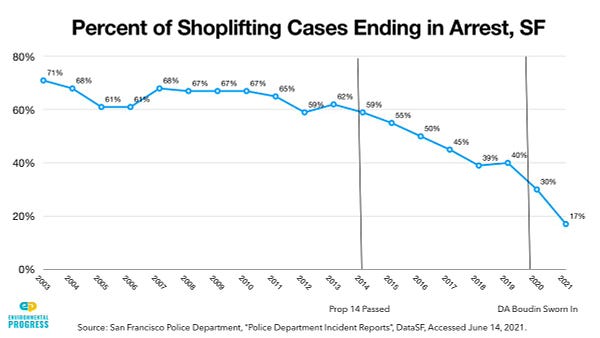 Some of this is probably because of Proposition 47, which made some forms of shoplifting punishable with citation rather than arrest (but wouldn’t that be a clear discontinuity rather than a gradual trend?) But overall it sure seems like shoplifting is being taken less seriously, which might encourage people to report less. Another statistic I see is that only 2.3% of shoplifting cases result in an arrest; I don’t know how this is different from the graph above with numbers in the 30s; maybe it involves different levels of what makes something a “case”. I accept that the data don’t consistently show a spike in shoplifting. But what’s the alternative? My patients who work in loss prevention in SF stores are all lying to me? The nice elderly Chinese man who sold me my last pair of glasses and chatted to me about the rampant shoplifting in his mall was lying? The San Francisco police are lying? Walgreens pretends to be concerned about shoplifting as part of a dastardly plot to close a bunch of stores for no reason? Target and CVS pretend to care about shoplifting as part of a plot to restrict their stores’ opening hours for no reason? Every big store near me has suddenly gotten a security guard at the front as part of some corporate-sponsored jobs program? Maybe the conservative narrative that soft-on-crime San Francisco must be experiencing rising crime rates took on a life of its own. Maybe it infiltrated not just the usual suspects like the SF police unions, but even such supposedly-liberal bastions as the New York Times. Maybe lots of big corporations took advantage of the fake narrative to make unpopular business decisions they were planning on making anyway. And maybe ordinary San Franciscans, confronted with everyone telling them they were in a shoplifting epidemic, started paying more attention to security guards and petty criminals who had always been there, a sort of mass hallucination that gripped everyone in the city. I can’t rule this out. Americans thought crime was rising all throughout the early 2000s, when it was in fact way down. Or maybe some statistics that we already know are off by several orders of magnitude got off by an additional factor of two or so. I think this one is more likely, but I’m genuinely not sure. Other Crime From the Economist: The Center on Juvenile And Criminal Justice puts it even more starkly, arguing that “San Francisco’s ‘Crime Wave’ Is Just One Crime”: This are potentially susceptible to the same reporting bias as shoplifting. So what about homicide? Homicide is practically always reported and investigated, making it a gold standard in crime measurement.
Looks pretty good until 2019. I don’t expect to gain useful information post-2020; the pandemic and the post-George-Floyd murder surge will make it impossible to evaluate for local variation. What about compared to other places? SF doesn’t make the top 20, although its neighbor Oakland does. Probably most murder variation in US cities is explained by percent African-American and maybe percent Borderer; with relatively few people in these groups SF was never in the running. I’m not sure if some abstracted version of the city with all demographic factors adjusted away would have an unusually high murder rate, but at that point it would be pretty distant from any interesting real-world question. You can see the leaderboard for other types of crime here; San Francisco is often in the top ten, but never the top three. As far as I can tell, San Francisco has seen a big spike in car breakins over the past few years, with no clear trend for other property crime, violent crime, or homicides. It’s not an outlier among American cities in any kind of crime. Conclusion of this section: San Fransicko’s specific claims are basically correct, but suggest a medium-term rise in SF crime which is mostly contradicted by the data. These show stable-to-decreasing murder, stable-to-decreasing violent and property crimes other than car break-ins, and large rises in car break-ins only. The data also show stable-to-decreasing shoplifting, but I’m not sure how much to trust them vs. common sense. Honestly, I’m pretty confused here and not sure what to think. Claim 7: Jim Jones (Of Kool-Aid Cult Fame) Used To Be The Chairman Of SF’s Housing AuthorityOkay, this isn’t really a statistical claim that I can research different perspectives on. Still, it’s so wacky that I couldn’t resist mentioning it in this review. Jim Jones, famous for killing everyone in his Guyana-based Jonestown cult with poisoned Kool-Aid, used to be the SF government’s top guy on homelessness. Shellenberger writes:
This is Shellenberger at his best: telling us crazy stories from the recesses of San Francisco history, maybe kind of spinning the narration in a way that makes all progressives seem guilty by association, but with the tale itself so gripping that it’s hard to be mad. And Jones wasn’t alone. This was the golden age of San Francisco cults, when (Shellenberger tells us) “more than half of all high school students in the San Francisco Bay Area reported at least one recruiting attempt by a cult member, and 40 percent reported at least three contacts.” This chapter of SF history came to an end in 1978, when Dan White, who had just resigned from San Francisco’s Board Of Supervisors (ie City Council) entered City Hall through a window and assassinated Mayor Moscone and fellow Supervisor Harvey Milk, then successfully got charges reduced to manslaughter through a legal manuever that has gone down in history as “the Twinkie Defense” (realistically the defense was that he was depressed, but reporters seized on a comment that implied it was because he ate too many Twinkies). Everything about 1970s San Francisco was like this. With the Mayor and his right-hand-man both dead, San Francisco leadership ended up in the hands of previously second-tier politician Dianne Feinstein. Feinstein was what passed for a moderate in 1970s SF (which meant she had been targeted for assassination by various left-wing groups - she survived when a bomb left on her windowsill failed to explode). In Shellenberger’s telling, she managed to clean up some of the mess and restore a semblance of normalcy. San Francisco never forgave her. Moscone - voting fraud committer, underage sex enjoyer, and Jim Jones’ bff - is beloved as a martyr in today’s SF, but (the book points out) Feinstein is so loathed that in 2021 the Board of Education voted to rename Dianne Feinstein Elementary School.
Claim 8: The Intolerant Left Shuts Down Debate On These IssuesAnother one that’s probably hard to do a randomized controlled trial on. You could probably predict that this one was coming - it’s a necessary narrative beat in this genre of book. I think this beat is good. My impression is that people who aren’t themselves public figures disagreeing with left-wing ideas still don’t understand how scary it is and how much hate you get. Maybe now that 2/3s of every political essay written over the past five years is about this topic, people will finally get it through their thick skulls that it exists and is bad. I would also note that “traumatizing the sorts of people who write popular books about politics, in a such a way that they feel compelled as a sort of self-therapy to write page after page telling readers how angry they should be at you and your whole coalition” isn’t great political praxis. I would like people to figure this out and stop doing it. Anyway, Shellenberger is doing his part in this effort:
And
And:
While I was reading the book, I came across this tweet, which suggests that being unimpressed with SF’s lefty homeless activist scene is not limited to Michael Shellenberger: Claim 9: European Cities Like Amsterdam Successfully Solved Their Own Drug And Homelessness Problems By Doing The Opposite Of SFShellenberger bases his plan to solve these problems on ideas that he says were pioneered in Amsterdam and spread to other European cities. In the 1980s, Amsterdam had the kinds of problems San Francisco deals with now: open-air drug markets, overdose deaths, homelessness, and crime. But in the 90s, they admitted they had a problem and took decisive action:
The Amsterdam strategy goes something like:
I was able to find Lessons Learned From The Amsterdam Cohort Study, which broadly backs up Shellenberger’s picture of declining drug use in Amsterdam, at least among the thousand-odd users in their study: A minor note of discord: this study characterized Amsterdam’s successful drug program as “harm reduction”, and its conclusion section is titled “Harm Reduction Works”. Shellenberger usually uses “harm reduction” to mean the soft-on-crime policies that don’t do what Amsterdam did. For example, here he points out that Amsterdam has fewer than 130 people using safe injection sites (a typical element of harm reduction strategies). But I gather this is for heroin only; they have many more people on methadone. Most people would also classify methadone treatment as a form of harm reduction. I think this is probably just a semantic quibble and we shouldn’t worry too much about it, but it threw me for a loop here. In any case, whatever harm reduction is or isn’t involved, it’s definitely true that law enforcement breaking up open-air drug markets was a big part of the program. Amsterdam’s crime rate has definitely been going down over the same period: Homelessness is a mixed bag. I couldn’t find any numbers that covered the entire period under discussion, but in 2006 people were talking about a “sense of urgency” in dealing with rising homelessness in the Netherlands, and homelessness has doubled in the past ten years. Still, how it did in the 1990s seems more relevant, and the the Dutch homelessness rate is still only about half of California’s. Also, like everyone else in the world, Amsterdam switched to Housing First several years ago. FEANTSA magazine says that “ever since 2015, Housing First has been the standing city-wide policy for solving homelessness in Amsterdam”. Like all articles of this type, it mentions how this has been proven to solve all problems and surely homelessness will stop existing any moment now (in fact, it’s stayed the same). How do we square San Fransicko’s story with this story? Amsterdam solved its problems by doing the opposite of Housing First in the 90s, then decided to switch to Housing First? I don’t know, maybe they just switched from a policy that works well in real life, for one that doesn’t work but sounds good on paper. Many such cases! On the other hand, Amsterdam continues to shelter all its homeless and not have tent cities, which I guess is most of what this policy package promises. Conclusion: San Fransicko’s description of Amsterdam solving its drug and crime problems matches the other sources I found, although I’m confused about how much harm reduction was involved. I can’t tell if it solved homelessness in the 90s, but it seems to have unsolved it shortly thereafter, in the sense that there are still many homeless people. Still, it continues to successfully shelter all its homeless people and avoid having them sleep on streets. Claim 10: San Fransicko Doesn’t Support “Sweeping Institutionalization” Of The Mentally IllAll of this started when I wrote about California governor candidates. My post described Shellenberger as opposing suboxone treatment and supporting “sweeping institution” of the mentally ill. A commenter quickly pointed out that I was wrong about suboxone (Shellenberger supports it when appropriate), and I quickly corrected that. But Shellenberger said on Twitter I was also wrong about the institutionalization claim: Now I have read the book, and it’s three straight chapters of saying that deinstitutionalization was bad and we need to institutionalize the mentally ill more. I’m sure Shellenberger isn’t deliberately lying here. I’m sure he thinks that the increased institutionalization that he wants somehow fails to qualify as “sweeping”. But he has exactly the same position that I’ve argued against again and again: deinstitutionalization was bad, the pet project of a few ACLU attorneys driven by fanaticism and nothing else. In the end it amounted only to trans-institutionalization, ie moving the mentally ill from psych hospitals into jails. Therefore we should make involuntary commitment easier. Some quotes to demonstrate he believes this:
Weird way to describe de-institutionalization if you support it.
Some would say that quoting people calling a thing “an evil synthesis” and “harmful”, and the state that does the thing as “one of the worst states” is evidence that a person does not like that thing. Also, this isn’t how people usually talk about civil liberties when they support them.
Doesn’t seem like the way someone would talk about this growing movement if they opposed it.
Agreed with whom? With him? Doesn’t that sound like he’s admitting he thinks more involuntary treatment is needed?
Shellenberger sure does hold a lot of Socratic dialogues with the ACLU trying to pick holes in their arguments against sweeping institutionalization of the mentally ill, for someone who supposedly agrees with them!
Now not wanting to involuntarily hospitalize people is “hemming and hawing” - sure, this is an interview subject and not Shellenberger himself, but most of the people he talks to is like this, and he never challenges this in the same way he challenges the ACLU.
This is sad and I have seen it happen - but writing about in these terms sure sounds like someone who supports more legal tools to impose involuntary care.
Every article supporting institutionalization uses some version of this statistic - here’s my 2016 essay arguing against it. It puts things into such sharp relief - why bother stopping involuntarily forcing mentally ill people up in the hospital, it asks, if they’re just going to get locked up in jail anyway? Shellenberger adds a grammatical ambiguity; I originally parsed his “every hospital in the country” as meaning “combined”, but this would be false, so charitably he is trying to say that LA County Jail has more than any single hospital. LA County Jail has 15,000 inmates; the largest psych hospital in the country has 1,400 patients. So if 10% of LA jail inmates had mental illnesses, this would beat the hospital. But NIMH says 20% of all Americans have mental illnesses, and 6% have serious mental illnesses. Is the definition of “mental illness” Shellenberger is using here closer to NIMH’s “mental illness” or “serious mental illness”? He just says “mental illness” and doesn’t explain. But he cites a book called Bedlam, which itself cites a report by the Treatment Advocacy Center. Do they mean something closer to NIMH’s “mental illness” or “serious mental illness”? You can find more information at my linked essay, but the short answer is that TAC describes itself as looking at “serious mental illness” but their definition is somewhat different from NIMH’s and probably not commensurable with it. It doesn’t matter anyway, because prisoners aren’t fully representative of the general population; just to give one example, they tend to be young, and young people from 18-25 have (as per NIMH) a 10% serious mental illness rate. That means that even if prisoners are no more likely to be seriously mentally ill than the general 18-25 population as per NIMH, Shellenberger’s “more mentally ill people in LA County Jail than in every hospital in the country” statistic is true! (I’m putting my finger on the scales here; men have a lower mental illness rate than women, so if you tried to find a true synthetic control for the average prisoner it might be lower than 10%. But add in poverty and it might be higher again! Who knows? Not Shellenberger, who didn’t do anything of the sort!) People see this statistic and think “Well, why bother giving mentally ill people rights, they’ll all just end up in jail anyway.” But the statistic is totally compatible with the mentally ill being no more criminal (and criminals being no more mentally ill) than anyone else! I don’t believe that’s literally true. I do believe that people in LA jail have a higher rate of mental illness than the general population. But I’m less sure if they have a higher rate of mental illness than eg graduate students, who have depression at 6x the rate of the general population. And if someone argued that it was a waste to shut down the old mental institutions, because we’re just “trans-institutionalizing” all the mentally ill from psych wards to graduate schools, then people would notice the flaws in that argument right away. If I sound angry about this, it’s because the old mental institutions were really, really bad. I’ve reviewed books about this before:
I have talked to nurses who used to work at these institutions. They sound kind of like death camps. There was often minimal interest in treatment (understandable, as most treatments back then didn’t work). Staff habitually abused patients physically, sexually, and emotionally. The “due process” for getting people into them was a joke, and people who were inconvenient to their families were often committed under false pretenses and kept in abominable conditions for the rest of their lives. At their height, these institutions housed 500,000+ people, a national tragedy on a scale matched only by mass incarceration and slavery. My impression is that winding them down was a straight victory for human flourishing. People keep coming up with arguments why they were good actually, and the arguments are always circumstantial and low quality. They’re either pure ecological fallacies - pointing out that prison populations increased around the same time psych ward populations decreased, without mentioning the whole history of lead poisoning and increasing sentencing strictness. Or they’re the dumb LA County Jail statistic which would be true even if mental illness and crime were completely uncorrelated. You’re allowed to believe circumstantial evidence if you want. You’re even allowed to support easier psych commitment. I honestly go back and forth on this. I’ve had some of my patients ruin their lives by becoming psychotic, in ways that I might have been able to solve if it was easier to involuntarily commit them. So I get it! Involuntary psych hospitalization is a terrible thing, but like imprisonment, it’s a terrible thing that sometimes proves necessary, and reasonable people can disagree on how hard to prioritize avoiding vs. avoiding the problems it solves. But I would be much happier if Shellenberger took a second between his denunciations of the people who ended 1950s-style psych commitment to admit the ways that it was a moral atrocity, or talk about how we could be sure that a modern policy of involunary hospitalization would do better. If you believe in increased institutionalization of the mentally ill, admit it and defend it! Don’t make me read your whole book to find out that in fact you’re in favor of it after all! Then I’ll be really annoyed and probably review the rest of it more harshly than it deserves! Conclusion: When I described Shellenberger as supporting sweeping institutionalization of the mentally ill, I was referring to exactly the set of policies he advocates in his book. The description linked to my review of My Brother Ron, which talks about exactly the set of policies Shellenberger talked about in his book. I will be editing my Mistakes page to clarify that this was not a mistake, and that it was a meta-mistake to list it on the Mistakes page originally. Book Review: San Fransickoa. That was fun. Time to review the actual book! The meat of San Fransicko is claims and stories like the ones above, presented in an unabashedly polemic style. It gets rounded out by interviews with current and former homeless people, drug addicts, social workers, and scientists, many of whom have fascinating stories and most of whom agree with Michael Shellenberger. I found the factual parts of the book very helpful in countering the one-sided narrative presented by the popular media. In a second, I’m going to criticize Shellenberger, but I feel bad about it. When the media presents a propagandist one-sided narrative, somebody needs to come in and set the facts straight. If they do it with perfect rationalist virtue, it tends to look like a long list of contradictory studies and statistics. The media says “every human being who has ever existed except for Hitler agrees that Housing First solves all problems!”. Suppose you write a book saying something like “actually, five studies say Housing First had a small positive effect on this problem, three studies say it had a small negative effect, and two studies say it was neutral”. The average citizen reads the media and concludes Housing First is perfect and amazing, then reads you and concludes that something something studies whatever. In the end they settle on something like “it’s perfect and amazing, but there’s some kind of asterisk after this and maybe more studies are needed”. If you want to actually shake them out of the propaganda, you need to go further and declare confidently that Housing First is actually bad. Michael Shellenberger does this, and in a moment I’ll blame him, but I want to stress that he’s less bad than the mainstream media he’s criticizing. He is taking swings at an omnipresent orthodoxy of creepily consistent spin and bias, while also telling a couple of fibs himself. So now, having given all those caveats - this book is not a good guide to the truth on complicated social science questions. It carefully avoids actual lies, while presenting one side of a two-sided case, sometimes so much so that I feel comfortable characterizing it as misrepresentation. As long as there are two scientists in the world who agree with San Fransicko, it’s “Here’s what scientists say…”. If there is one statistic that supports a point and five that oppose it, you can guess which one the book brings up. Aside from its polemic, it’s also a guide to recent San Francisco political history. In that role, it’s great. It clearly has an axe to grind, as long as you remember that, it has some amazing stories. b. The list of Claims above doesn’t showcase this, but aside from social science and political history, this is also a book of moral philosophy. Shellenberger follows Viktor Frankl, the humanist psychotherapist who wrote about the search for personal meaning (also the guy credited with the quip about a Statue of Responsibility on the West Coast to match the Statue of Liberty on the East). There’s a lot of writing on Victimology (capital V, presented as a religion) and how it contrasts with Frankl’s ethos of meaning and responsibility. I don’t really have a strong opinion on this. I can think of ways that people are victims and it’s important to acknowledge that and treat them appropriately, and also ways that taking responsibility and not wallowing in victimhood is psychologically healthy and important. Probably San Francisco progressives are too far to the victimology end of the scale and could benefit from taking Shellenberger’s thoughts on the matter seriously. I still feel conflicted on this without really being able to verbalize why. Maybe something like: these are profound psychological truths, but their failure mode is to be reduced to preachiness and haranguing. And in a book called San Fransicko: Why Progressives Ruin Cities, there’s almost no way not to have them sound like preachiness and haranguing. It’s like how calling out injustice and highlighting the cruelty of those who ignore the less fortunate is all nice and well when Victor Hugo does it - but if the book is by Rachel Maddow, I am just going to skip those parts. (and yet if I ignore anyone who gives me an important message, just because they’re associated with the kind of people who tend to do that kind of thing, I will have closed myself off to a lot of morally important communication. A puzzle.) c. San Fransicko also briefly confronts libertarians, who it treats as allied with progressives on these issues (as if progressives would accept alliances with the likes of us!) Still, its confrontation is not unfair. If we reject the extreme-maybe-strawman leftist view that drug addicts and the like are complete victims of their own circumstances who never made any bad choices, then the question arises: given that they are making bad choices, should they be allowed to do so? Shellenberger says no: using hard drugs is a bad enough choice that it’s worth enforcing (some) anti-drug laws and (softly) forcing treatment on addicts who can’t overcome their addictions themselves. A libertarian who accepts neither the strawman-leftist denial of agency nor Shellenberger’s principled commitment to using force here has to say . . . what? That it’s okay for these people to die slowly (sometimes not so slowly) because that’s what they chose? When it seems obvious that, given a little push, so many of them would choose something different? A confession: I sometimes use substances I’m not supposed to. Nothing as bad as the sob stories in San Fransicko - “research chemicals”, not speed or fentanyl. But still, I see the Abstracted Will Of The American People saying it knows better than me what substances I’m allowed to take, and I say no, you’re wrong. Is it hypocritical of me to then join a coalition saying we know better than some homeless crack addict what substances he should be allowed to take? I mean, I am mostly right when I defy the will of the people (I have learned useful things, and haven’t yet come to real harm), and the homeless person is wrong (he is a homeless crack addict). But on the Outside View, wanting to institute a law I fully intend to break, where I would get enraged if it were applied against me personally, seems somewhat hypocritical. I’m even more torn on the other civil rights question the book confronts, whether homeless people who hate shelters should be allowed to camp in tents. The libertarian reluctance to provide free health care has a very understandable justification: it wasn’t the government or the taxpayers who made you sick, so they have no obligation to make you healthy again. But ten thousand years ago, before there were governments or private property at all, anyone could camp wherever they wanted. If the government bans people from sleeping on land, that’s making them worse than if the government didn’t exist at all; it’s a violation of their pre-existing rights. Some amount of this is unavoidable if you accept private property. But the idea that people can’t be anywhere at all, and must agree to be warehoused in a crowded and unpleasant shelter, seems like another, much higher level of imposition. The way I cut through both these problems is to have a high tolerance for people doing what they want, but a low tolerance for them impinging on the rights of others. I’m fine with a compromise where people can camp on public land, but if they start harassing people or piling up trash, the government can take action. This probably means Shellenberger and I agree on most real-world cases, but I remain invested in the tiny sliver of moral difference between our positions. d. Along with all the problems and preaching, San Fransicko offers solutions. These won’t come as a surprise to anyone who’s read this far: they’re basically the Amsterdam plan presented earlier. Break up open-air drug markets. Force addicts into rehab by threatening prison sentences for noncompliance. Ban camping on streets and force the homeless into shelters. Offer permanent housing when appropriate, but make it contingent on good behavior. Have a strong psychiatric system with ability to commit people who need it, and enforced outpatient treatment when appropriate. Would these work? I’m pretty sure they would work well for housed people and the city as a whole. Homeless people would no longer block the streets and assault passers-by; they would be safely out of sight in shelters or in mental institutions. A new generation of tough DAs would crack down on crime. Stores could reopen, and citizens could walk the streets without fear. It’s hard for me to imagine this not working. So the remaining question is: would this be better or worse for the homeless (and addicts, criminals, etc) themselves? The argument against: shelters, mental institutions, and prisons are all really bad (see above). The argument in favor: mental illness and drug abuse are also really bad, and maybe being in these kinds of institutions (or being threatened with them) could help people seek treatment. Then their lives would be better, they could get out of the institutions, and they could be happier than if they were left to their own devices. I think this might be true, but I am skeptical. The dream is to be so tough on crime that criminals pre-emptively give up and you never have to deploy your draconian punishments. But the history of the past few decades of mass incarceration show that, although this happens a little, enough people keep doing crime that you very much do have to deploy your draconian punishments and then you end up with millions of people in prison. While some of these people find God and get better, many others become even more hardened into the criminal lifestyle or just sort of rot away. I have worked in several mental institutions and although I think we do good work and some patients benefit, I would not describe us as being super-great at getting the most severe cases to the point where they can be productive members of society again. This is also my experience with drug rehabs. They are very helpful to some people, but the majority of studies struggle to find any effect when the justice system forces people into them. So without wanting to say that this wouldn’t happen at all, I’m not sure it would outweigh the real moral cost of these programs. Suppose that in fact, San Fransicko’s policies would be worse for the underclass, but better for everyone else. Does that make them good or bad? I know the answer we’re supposed to give: it’s callous to care more about rich people’s comfort than about poor people’s freedom. But there are a lot more non-homeless people than homeless people, and a lot more people who buy things lawfully than shoplifters, etc. Does it actually balance out? Probably not through crime. The average person isn’t victimized by crime very often. There are about 1000 robberies a year in San Francisco (I think this is like mugging?), and another 1000 assaults. There are about 7000 homeless people - not all of them are criminals or addicts, but presumably there are a lot of criminals/addicts with houses, so let’s say a total of 20,000 people in this group. For the sake of argument, stricter policies will make half of them find God, and the other half will need to be forced into shelters/prisons/hospitals. And for the sake of argument, let’s say this ends all violent crime in San Francisco. You’d be institutionalizing 10,000 people a year, to prevent 2000 violent crimes a year. Even accepting that violent crimes are traumatizing and really bad, this doesn’t seem very utilitarian - being the victim of a violent crime would have to be 5x as bad as being forced to spend a year in an institution. Maybe this is thinking about it wrong. Being in crime-filled scary ghettos really negatively affects people’s quality of life. If “cleaning up the city” removed half of the quality-of-life difference between poor neighborhoods and rich neighborhoods, that would be a really big deal for a lot of poor people. I think this would matter a lot - that most of the damage from urban dysfunction isn’t overt crime. It’s litter, graffiti, literal broken windows, parks that smell like marijuana and are strewn with used needles. People blasting loud music in public places or residential streets at all hours of the night. People staying away from mass transit transportation or public parks or any public spaces at all because they know they’ll be yelled at and harassed or just have to deal with a low-grade miasma of disgust over everything, preventing a real Jane-Jacobs-style civic life from ever taking shape. Class segregation, because anyone who can get out of the dysfunctional areas is desperate to do that. The fall of civic pride, because cities get hard to be proud of. If there are 100,000 San Franciscans who live in bad areas, and “cleaning up the cities” improved their quality of life 10%, and institutionalization lowers 10,000 people’s quality of life by 50%, that could . . . potentially work out? Also, what about NIMBYism? People have cogently argued that many of our worst problems - from high housing prices to declining technological progress - are downstream of our decision to stop building dense cities and walkable neighborhoods. But a big reason we don’t build dense cities and walkable neighborhoods is that people (correctly) hate and fear them. They accurately predict that if their neighborhood got denser, it would start looking like the dense parts of San Francisco - litter-filled, decaying, disgusting, unsafe, and ambiently miserable to exist in. The reason we don’t have better public transportation in the Bay Area is that people protest every time someone tries to build a BART station in their area - and the reason people protest every time someone tries to build a BART station in their area is that they weren’t born yesterday, and they’ve seen what other BART stations and the areas around them are like. If the government proved to citizens that it was capable of keeping cities liveable, maybe they wouldn’t resist cities and transit so hard, and then that would cause a lot of downstream improvements. I have to admit - I talk a good utilitarian talk on this, but I don’t know if I live up to my ideals. An addictionologist interviewed in San Fransicko heaps contempt on well-off liberals who get the benefits of virtue-signaling while externalizing the costs onto poor people in bad areas:
So I imagine - what if I lived in the worst parts of SF, had people crap on my front steps every day, had all my packages stolen, and (by the bounds of this hypothetical) wasn’t allowed to move to the suburbs, ever? I think I would last two weeks before I sacrificed all of my principles on the altar of “less human feces, please”. (an obvious next step would be to put myself in the shoes of a criminal who doesn’t want to go to prison, but here I have more trouble sympathizing - I would simply not commit crimes.) This thought experiment pushes me closer to Shellenberger’s side of the aisle. I still want to cling to the hope that there is some way to do this which lets the people who aren’t bothering anyone else be left alone. But something has to give. e. The Native Americans had a saying: never judge a man until you’ve walked a mile in his moccasins and you’re sure he’s not going to be your governor. Now that Shellenberger has lost the primary, I am happy to judge him. My judgment is: mixed bag. San Fransicko does a good job skewering orthodoxies on some important topics. It thinks hard about them and often has good ideas. It looks at a problem that needs solving, and proposes plans that would probably solve it. When I dislike its policy prescriptions, they’re usually on complicated ethical questions where principled people can disagree. The one virtue I cannot ascribe it is honesty. The old saying talks about the man who “uses statistics the way a drunk uses a streetlight; for support rather than illumination”. San Fransicko is the equivalent of that dim blue lighting you sometimes see in nightclub bathrooms: so focused on preventing injection drug use that it sacrifices the ability to illuminate anything at all. It makes me mad. This book was so close to the level where I would feel comfortable recommending it to friends. But in the end it does not clear that bar. I kind of want to yell at Shellenberger. I could do it, I think. His office is two blocks from mine. Probably I will run into him on the street one day. I could accost him and start shouting. But it wouldn’t help: this happens to him every day already, and he’s learned to completely tune it out. I could try violence. Surely that would get his attention. But no, this happens to him all the time too, and would probably just earn me a footnote in his next book. Maybe I could clarify. “THIS VIOLENCE I’M DOING IS BECAUSE OF THE BOOK YOU WROTE. I’M ATTACKING YOU ON ACCOUNT OF YOUR POLITICAL BELIEFS!” But this, too, seems to be something he expects and is entirely prepared for. I’d just get a nod of the head, and a paragraph about me in the sequel. We Bay Areans are a difficult breed to criticize. This explains a lot, if you think about it. San Fransicko tries its best to set us straight. But like a drug addict assaulting passers-by in the Tenderloin, it’s too unbalanced for its punches to land consistently. You’re a free subscriber to Astral Codex Ten. For the full experience, become a paid subscriber. |
Older messages
Open Thread 229
Monday, June 20, 2022
...
Your Book Review: The Future Of Fusion Energy
Friday, June 17, 2022
...
Peer Review: Nightmares
Friday, June 17, 2022
...
Mantic Monday 6/14/22
Monday, June 13, 2022
...
Open Thread 228
Monday, June 13, 2022
...
You Might Also Like
How to Keep Providing Gender-Affirming Care Despite Anti-Trans Attacks
Sunday, March 9, 2025
Using lessons learned defending abortion, some providers are digging in to serve their trans patients despite legal attacks. Most Read Columbia Bent Over Backward to Appease Right-Wing, Pro-Israel
Guest Newsletter: Five Books
Sunday, March 9, 2025
Five Books features in-depth author interviews recommending five books on a theme Guest Newsletter: Five Books By Sylvia Bishop • 9 Mar 2025 View in browser View in browser Five Books features in-depth
GeekWire's Most-Read Stories of the Week
Sunday, March 9, 2025
Catch up on the top tech stories from this past week. Here are the headlines that people have been reading on GeekWire. ADVERTISEMENT GeekWire SPONSOR MESSAGE: Revisit defining moments, explore new
10 Things That Delighted Us Last Week: From Seafoam-Green Tights to June Squibb’s Laundry Basket
Sunday, March 9, 2025
Plus: Half off CosRx's Snail Mucin Essence (today only!) The Strategist Logo Every product is independently selected by editors. If you buy something through our links, New York may earn an
🥣 Cereal Of The Damned 😈
Sunday, March 9, 2025
Wall Street corrupts an affordable housing program, hopeful parents lose embryos, dangers lurk in your pantry, and more from The Lever this week. 🥣 Cereal Of The Damned 😈 By The Lever • 9 Mar 2025 View
The Sunday — March 9
Sunday, March 9, 2025
This is the Tangle Sunday Edition, a brief roundup of our independent politics coverage plus some extra features for your Sunday morning reading. What the right is doodling. Steve Kelley | Creators
☕ Chance of clouds
Sunday, March 9, 2025
What is the future of weather forecasting? March 09, 2025 View Online | Sign Up | Shop Morning Brew Presented By Fatty15 Takashi Aoyama/Getty Images BROWSING Classifieds banner image The wackiest
Federal Leakers, Egg Investigations, and the Toughest Tongue Twister
Sunday, March 9, 2025
Homeland Security Secretary Kristi Noem said Friday that DHS has identified two “criminal leakers” within its ranks and will refer them to the Department of Justice for felony prosecutions. ͏ ͏ ͏
Strategic Bitcoin Reserve And Digital Asset Stockpile | White House Crypto Summit
Saturday, March 8, 2025
Trump's new executive order mandates a comprehensive accounting of federal digital asset holdings. Forbes START INVESTING • Newsletters • MyForbes Presented by Nina Bambysheva Staff Writer, Forbes
Researchers rally for science in Seattle | Rad Power Bikes CEO departs
Saturday, March 8, 2025
What Alexa+ means for Amazon and its users ADVERTISEMENT GeekWire SPONSOR MESSAGE: Revisit defining moments, explore new challenges, and get a glimpse into what lies ahead for one of the world's

